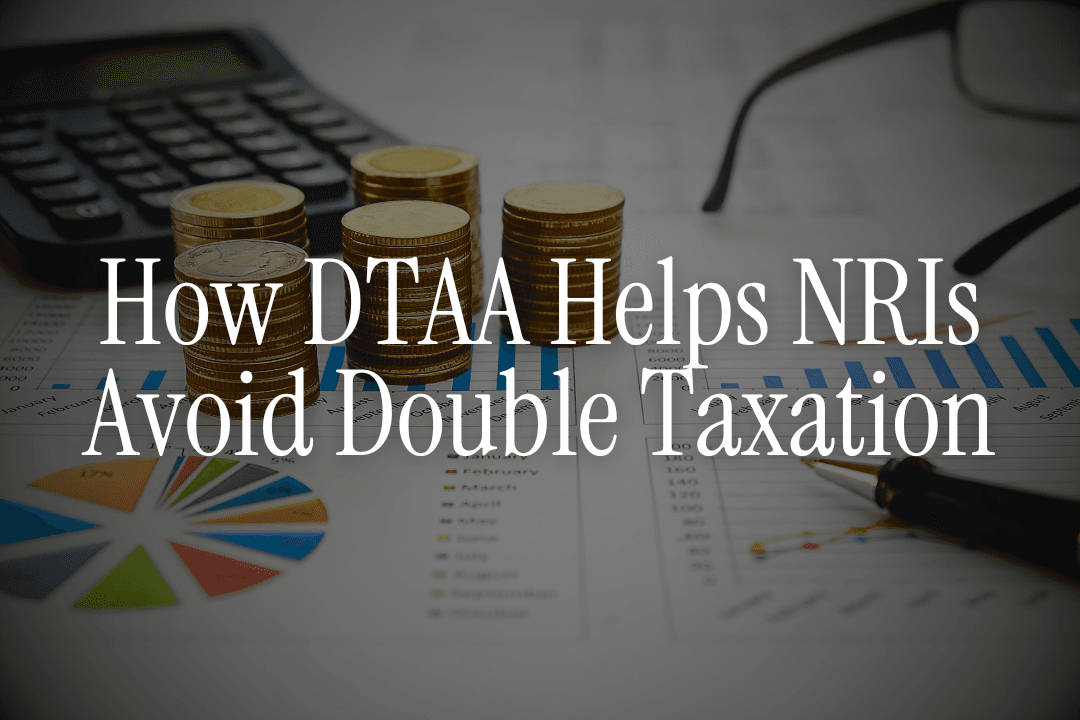
Priya, an NRI residing in Dubai received her Indian tax notice showing ₹85,000 due on her FD interest. But she had already paid tax in UAE!
Sound familiar?
You're earning money in India (maybe from rent, FDs, or dividends). Your resident country might also want to tax this income. Suddenly, you're looking at paying tax twice on the same money.
Here's what most NRIs don't realize: You have legal protection against this through DTAA - the Double Taxation Avoidance Agreement. It's not some complex loophole. It's your right.
By the time you finish reading this, you'll know exactly which DTAA benefits you can claim, how to calculate your savings (some of my clients save ₹50,000+ annually), and the step-by-step process to ensure you never overpay again.
Let's start with Priya's story and how we fixed her tax situation in 20 minutes.
What is DTAA and Why Your Tax Consultant May Not Have Told You
DTAA stands for Double Taxation Avoidance Agreement. Think of it as a treaty between India and your resident country that says: "We won't let the same income get taxed twice."
Here's what happened to Priya:
- She earned ₹3.5 lakhs interest from Indian FDs
- Indian bank deducted 30% TDS = ₹1.05 lakhs
- UAE has no income tax, so no additional tax there
- But she still paid 30% when she could have paid just 12.5% under India-UAE DTAA
- Her overpayment: ₹61,250
India has signed DTAAs with over 90 countries specifically to prevent this situation. The most important ones for NRIs include UAE, USA, UK, Singapore, Canada, and Australia.
👉 Tip: If you're paying the full 30% TDS on Indian income and live in a DTAA country, you're likely overpaying. This is money you can get back.
The Hidden Cost of Not Using DTAA (Real Numbers)
Let me show you what DTAA ignorance costs NRIs every year:
Case 1: Software Engineer in Dubai
- ₹50 lakhs in Indian FDs earning 7% = ₹3.5 lakhs interest
- Without DTAA: 30% tax = ₹1.05 lakhs
- With UAE DTAA: 12.5% tax = ₹43,750
- Annual overpayment: ₹61,250
Case 2: Doctor in New York
- ₹2 lakhs dividend from Indian shares + ₹1.5 lakhs FD interest
- Without DTAA: Combined tax burden ~60% (US + India)
- With USA DTAA: Effective tax ~25% (with foreign tax credit)
- Annual savings: ₹50,000+
Case 3: Consultant in London
- ₹8 lakhs rental income from Mumbai property
- Without DTAA: 30% in India + UK tax on same income
- With UK DTAA: Tax in India, claim credit in UK
- Saving: Avoid double taxation entirely
The pattern is clear. NRIs who don't use DTAA pay 30-60% more tax than they should.
Which Countries Have the Best DTAA Deals with India
Not all DTAA agreements are created equal. Here's the hierarchy of benefits:
Tier 1 (Excellent Benefits)
UAE:
- Interest: 12.5% (lowest rate)
- Dividend: 10%
- Capital gains: Often exempt for UAE residents
- Best for: NRIs with high FD exposure
Singapore:
- Interest: 15%
- Dividend: 15% (best rate among major countries)
- Strong business profit provisions
- Best for: Business owners and investors
Tier 2 (Good Benefits)
USA:
- Interest: 15%
- Dividend: 25% (note: higher than standard 20%)
- Social security benefits covered
- Best for: NRIs with diversified income
Also Read - DTAA Between India and USA: Benefits & How to Claim Them
UK:
- Interest: 15%
- Dividend: 15%
- Favorable pension income rules
- Best for: Employment income and pensions
Tier 3 (Standard Benefits)
Canada, Australia, Germany: Generally 15-20% rates across income types.
Countries Without DTAA
If your resident country doesn't have DTAA with India, you can still claim unilateral relief under Section 91 of the Income Tax Act.
👉 Tip: Tip: UAE has one of the lowest dividend tax rates (10%) among major DTAA countries, making it attractive for NRIs with significant Indian equity investments.
The Three Ways DTAA Can Save You Money
DTAA offers three relief methods. You can often choose the most beneficial one:
Method 1: Exemption
Income is completely exempt from tax in one country.
Example: Rajesh works in UAE for over 183 days. His UAE salary is completely exempt from Indian tax. Since UAE has no income tax, he pays zero tax on this income.
Method 2: Foreign Tax Credit (Most Common)
Pay full tax in both countries, then claim credit for foreign tax paid.
Real walkthrough:
- You earn ₹10 lakhs from Indian sources
- India deducts 30% TDS = ₹3 lakhs
- Your resident country also taxes this income at 25% = ₹2.5 lakhs
- You claim ₹2.5 lakhs as foreign tax credit in India
- Your final Indian tax: ₹3 lakhs - ₹2.5 lakhs = ₹50,000
Method 3: Reduced Rate
Pay tax at DTAA's special reduced rate instead of standard rates.
This is where most savings happen. Instead of 30% standard NRI rate, you pay DTAA rates:
- UAE residents: 12.5% on interest
- US residents: 15% on interest
- UK residents: 15% on interest
Also Read - How to Claim DTAA Benefits in India: Complete Step-by-Step Guide
Step-by-Step: How I Help My Clients Claim DTAA Benefits
Here's the exact process I guide NRIs through:
Step 1: Confirm Your Tax Residency Status
Use our residential status calculator first. You need to be a tax resident of a DTAA country, not just living there.
Key tests:
- Physical presence (usually 183+ days)
- Tax obligations in that country
- Permanent home location
Step 2: Get Your Tax Residency Certificate (TRC)
This is the single most important document. Here's where to get it:
UAE: Federal Tax Authority (4-6 weeks processing)
USA: IRS Form 6166 (8-12 weeks)
UK: HM Revenue & Customs (6-8 weeks)
Singapore: IRAS (2-4 weeks)
👉 Tip: Apply for TRC before the financial year begins. Many NRIs miss out on DTAA benefits because they get TRC too late.
Step 3: Choose Your Strategy
For Immediate Relief (Proactive):
- Submit TRC + Form 10F to Indian income sources
- They'll deduct TDS at reduced DTAA rates going forward
- Best for: Regular income like rent, FD interest
For Past Years (Reactive):
- File Form 67 before your tax return
- Claim foreign tax credit for taxes paid abroad
- Best for: One-time income like property sales
Step 4: Execute Based on Income Type
For Interest Income:
- Submit TRC to your bank
- File Form 10F electronically
- Bank deducts TDS at DTAA rate (e.g., 12.5% for UAE vs 30% standard)
For Rental Income:
- Give TRC to tenant or property manager
- They deduct TDS at DTAA rate
- You claim foreign tax credit when filing returns
For Dividend/Capital Gains:
- Usually handled automatically if you have valid TRC
- Claims made during ITR filing
The Documents That Can Make or Break Your Claim
Getting DTAA benefits isn't automatic. You need the right paperwork:
Essential Documents
- Tax Residency Certificate (TRC) - Without this, no DTAA benefits
- Form 10F - Declaration of your residency status
- Form 67 - For claiming foreign tax credit (must file before ITR)
- PAN Card - Mandatory for all tax benefits
Supporting Documents
- Proof of foreign tax paid (tax returns, payment receipts)
- Bank statements showing Indian income received
- TDS certificates from Indian payers
- Investment documents (FD receipts, property papers)
Common document mistakes I see:
- TRC expired or for wrong assessment year
- Form 67 filed after ITR submission (this disqualifies your claim)
- Foreign tax payment proof in wrong currency format
Country-Specific Walkthroughs: What Actually Works
Let me show you how DTAA works in practice for different countries:
UAE Residents: The Tax-Free Sweet Spot
Profile: Software manager in Dubai, ₹40 lakhs in various Indian investments
Income Sources:
- ₹2.5 lakhs FD interest
- ₹1.5 lakhs dividend income
- ₹6 lakhs rental income
Without DTAA Tax: ₹3 lakhs (30% on all income)
With UAE DTAA Tax: ₹1.4 lakhs (12.5% on interest, 15% on dividends, 30% on rent)
Annual Savings: ₹1.6 lakhs
Key advantage: UAE has no personal income tax, so whatever you save in India is your total benefit.
USA Residents: Complex But Rewarding
Profile: IT professional in California, ₹25 lakhs in Indian assets
The US taxes global income, so you'll pay US tax anyway. But DTAA prevents paying both US and Indian tax on the same income.
Strategy:
- Pay reduced rate in India (15% vs 30% on interest)
- Claim Indian TDS as foreign tax credit in US returns
- Net effect: Pay only US rates, avoid double taxation
Benefit: Can save 15% points on Indian income tax, plus get US foreign tax credit.
UK Residents: Pension-Friendly Rules
Profile: Returned NRI with UK pension + Indian investments
Special advantage: UK DTAA has favorable pension provisions. UK pensions are often taxed only in the UK, not in India, even if you become Indian resident.
👉 Tip: If you're planning to return to India from the UK, understand pension taxation under DTAA before changing your residency status.
Also Read - DTAA vs. Non-DTAA Countries
When DTAA Won't Help You (Important Limitations)
DTAA isn't magic. Here's when it won't work:
Limitation 1: You're Not Really a Tax Resident
Just having a visa doesn't make you a tax resident. You need genuine tax obligations in the DTAA country.
Red flags:
- You don't file tax returns in your resident country
- You spend less than 183 days in the DTAA country
- You have no permanent home there
Limitation 2: Treaty Shopping
Using artificial structures to claim unintended benefits is prohibited.
Example: Creating a Singapore company just to route Indian income and claim Singapore DTAA benefits won't work. You need real business substance.
Limitation 3: Permanent Establishment Issues
If you have significant business operations in India (permanent establishment), normal business tax rules apply instead of DTAA benefits.
Limitation 4: Income Not Covered
DTAA doesn't cover:
- Penalties and interest on defaulted taxes
- Some types of business income
- Income from illegal activities
👉 Tip: If your DTAA claim gets rejected, check if you meet all residency tests. This is the most common reason for rejection.
Advanced DTAA Strategies for High-Net-Worth NRIs
For NRIs with significant Indian exposure, here are sophisticated strategies:
Strategy 1: Timing Your Residency Changes
Scenario: You're moving from Dubai to London for work.
Issue: UAE has better DTAA rates (12.5% vs 15% on interest) but you're changing countries mid-year.
Solution: Time your income recognition and TRC applications to maximize the lower rate period.
Strategy 2: Investment Structure Optimization
Consider: GIFT City investments for significant tax exemptions and concessions, eliminating the need for DTAA altogether.
Comparison:
- Traditional NRE FD with DTAA: 12.5-15% tax
- GIFT City USD FD: 0% tax
- Clear winner: GIFT City for tax efficiency
Strategy 3: Mixed Residency Planning
For returning NRIs: Use your RNOR (Resident but Not Ordinarily Resident) status for 2 years after return. Combine this with DTAA for maximum benefit.
Common Costly Mistakes (And How to Avoid Them)
After helping 500+ NRIs with DTAA claims, here are the mistakes that cost the most money:
Mistake 1: Waiting Until Tax Filing Season
Cost: Missing an entire year of reduced TDS rates
Solution: Get TRC and submit Form 10F at the start of the financial year
Mistake 2: Not Understanding Currency Conversion Rules
Cost: Incorrect foreign tax credit calculations
Solution: Foreign tax must be converted using SBI's telegraphic transfer buying rate on the last day of the previous month
Mistake 3: Assuming All Banks Handle DTAA Automatically
Reality: Many bank branches don't understand DTAA procedures
Solution: Choose NRI-focused banks and submit documents to their specialized NRI branches
Mistake 4: Mixing Up Form Filing Sequence
Cost: Cannot claim foreign tax credit, losing thousands
Solution: Always file Form 67 BEFORE submitting your ITR, never after
Mistake 5: Ignoring State-Level Complications
Example: If you're a US resident, different states have different treaty benefits
Solution: Consult tax experts familiar with both countries' laws
Recent DTAA Updates That Affect You in 2025
Tax laws evolve constantly. Here's what changed recently:
UAE's New Corporate Tax
The UAE introduced 9% corporate tax in 2023 (with exceptions for individuals).
This affects:
- NRIs with UAE business structures
- Tax residency calculations for business owners
- Optimal investment routing strategies
Source: UAE Ministry
Enhanced Information Exchange
India now has automatic information exchange agreements with most DTAA countries.
This means:
- Tax authorities share financial data automatically
- Higher compliance requirements
- Greater scrutiny of DTAA claims
Section 89A Benefits
New provisions for NRIs with foreign retirement accounts in notified countries, providing relief from double taxation on retirement income.
*notified countries include: USA, UK, and Canada (Source)
👉 Tip: The enhanced information exchange makes proper documentation even more critical. Ensure all your DTAA claims are well-supported.
Beyond DTAA: Modern Alternatives for Tax-Smart NRIs
While DTAA is powerful, consider these alternatives:
GIFT City: The Tax-Free Alternative
Instead of paying even reduced DTAA rates, consider GIFT City fixed deposits that offer:
- 0% tax on interest (vs 12.5-15% under DTAA)
- USD denomination (currency hedge)
- Simplified compliance
Strategic Asset Allocation
Combine DTAA optimization with smart asset allocation:
- High-interest instruments in DTAA-protected countries
- Growth investments in tax-efficient structures
- Emergency funds in easily accessible NRE accounts
Estate Planning Considerations
DTAA also covers estate and gift taxes. Consider this when structuring wealth transfer to family members in India.
Tools and Resources for DIY DTAA Management
Official Government Resources
- Income Tax DTAA Portal: incometaxindia.gov.in/pages/international-taxation/dtaa.aspx
- Form Download Center: Get Forms 67, 10F from the IT Department
- Tax Treaty Texts: Download complete DTAA documents
Also Check Check your tax residency with Residential Status Calculator: Professional Resources
- Qualified Tax Professionals: Use our network of India-qualified CAs with international experience
- Country-Specific Experts: Specialists in UAE, US, UK, Singapore tax laws
Real Client Success Stories
Success Story 1: The Dubai Family
Background: Family of 4 in Dubai, ₹1.2 crores in Indian investments
Problem: Paying ₹8.5 lakhs annual tax without DTAA optimization
Solution: Implemented DTAA + moved 60% to GIFT City
Result: Annual tax reduced to ₹2.1 lakhs (75% reduction)
Success Story 2: The Silicon Valley Executive
Background: Tech VP in California, complex income from stock options, Indian property
Problem: Double taxation eating 45% of Indian rental income
Solution: Structured DTAA claims + optimized timing of stock option exercises
Result: Effective tax rate reduced from 45% to 28%
Success Story 3: The London Consultant
Background: Financial consultant with UK pension + Indian business income
Problem: Unclear on pension taxation after returning to India
Solution: Used DTAA provisions + RNOR status optimization
Result: UK pension remained UK-taxed only, saving ₹3.2 lakhs annually
When to Consult Professionals vs DIY
DIY is fine when:
- You have simple income sources (FDs, rent)
- You're confident about your residency status
- Your resident country has clear DTAA provisions
- Your annual Indian income is under ₹10 lakhs
Get professional help when:
- You have business income or capital gains
- You've changed countries recently
- You have income from multiple countries
- You're planning major transactions (property sale, business exit)
- Your situation involves estate planning
- You're dealing with US state taxes or other complex jurisdictions
💡 The cost of professional advice is typically 5-10% of the tax you'll save. It's almost always worth it for complex situations.
Your Action Plan: What to Do Right Now
Based on your situation, here's your immediate next step:
If You've Never Claimed DTAA Benefits:
- Check if your country has DTAA with India using the official portal
- Apply for Tax Residency Certificate immediately (processing takes weeks)
- Calculate your potential savings using our DTAA calculator
- Submit Form 10F for current year income sources
If You're Already Using DTAA:
- Review if you're using the optimal method (exemption vs credit vs reduced rate)
- Consider GIFT City alternatives for new investments
- Update documentation if you've changed countries or residency
If You're Planning to Change Countries:
- Understand both countries' DTAA terms before moving
- Time your transition to maximize tax benefits
- Consider investment rebalancing based on new country's DTAA rates
👉 Tip: Start with getting your TRC. This single document unlocks all DTAA benefits, and most NRIs don't have it updated.
Key Takeaways
Here's what you now know about DTAA that most NRIs don't:
The Big Picture: DTAA can save you 30-75% on your Indian tax liability, but only if you have the right documentation and follow the correct procedures.
The Money Impact: Typical NRI saves ₹50,000-₹2,00,000 annually through proper DTAA optimization. High-net-worth individuals save much more.
The Process: Get TRC from your resident country → Submit Form 10F to Indian income sources → Claim benefits via reduced TDS or foreign tax credit.
The Mistakes to Avoid: Not getting TRC on time, filing Form 67 after ITR, assuming all banks understand DTAA, ignoring residency status changes.
The Modern Alternative: Consider GIFT City investments offering 0% tax instead of even reduced DTAA rates.
The Bottom Line: DTAA isn't optional for smart NRIs - it's essential financial hygiene, like having health insurance.
The biggest mistake I see is NRIs who know about DTAA but don't take action. They keep paying 30% tax year after year, thinking "I'll deal with this next year."
That procrastination costs real money. ₹50,000 overpaid this year is ₹50,000 that could have gone into your child's education fund or your retirement corpus.
Ready to stop overpaying? Download the Belong app to access our DTAA calculator and explore tax-free GIFT City investment options. Join our UAE NRI WhatsApp group to connect with other NRIs who've successfully optimized their taxes.
Your future self will thank you for taking action today.
Sources: Income Tax India Bajaj Finance India UAE DTAA India US DTAA India Singapore DTAA UAE Ministry
This guide is for educational purposes and doesn't constitute tax advice. Tax laws change frequently, and individual situations vary. Always consult qualified tax professionals in both India and your resident country before making financial decisions.




